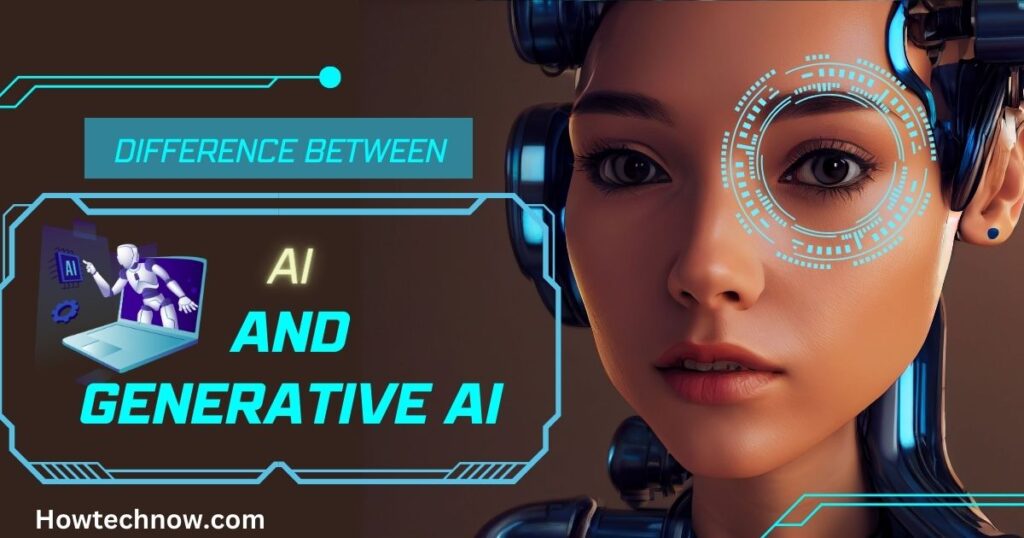AI stands for artificial intelligence. Artificial Intelligence (AI) is like a part of computer science. It’s about making smart computer programs that can think, learn, and do things by themselves. AI research has done really well in finding ways to solve many different problems, like playing games and diagnosing illnesses.
One kind of AI is called “Generative AI.” It’s the kind of AI that can make new things like pictures, words, and music. It does this by learning the patterns and structure of existing data and then using that knowledge to generate new data that has similar characteristics. Generative AI models are trained on massive datasets of data, such as images of faces, text from books and articles, or musical pieces. Once trained, the model can be used to generate new data, even if it has never seen that data before.
Table of Contents
How does generative AI work?

Generative AI works by learning the patterns and structure of existing data and then using that knowledge to generate new data that has similar characteristics. Generative AI models are trained on massive datasets of data, such as images of faces, text from books and articles, or musical pieces. Once trained, the model can be used to generate new data, even if it has never seen that data before.
There are a variety of different generative AI models, but they all work on the same basic principle. The model is first trained on a dataset of existing data. This training data is used to teach the model the patterns and structure of the data. Once the model is trained, it can be used to generate new data by sampling from the probability distribution that it has learned.
For example, a generative AI model trained on images of faces could be used to generate new faces that look realistic. The model would do this by sampling from the probability distribution of facial features that it has learned. This would produce a new face that is similar to the faces in the training data, but not identical.
Generative AI is a powerful tool that has the potential to revolutionize many industries. It can be used to create new products, design new marketing campaigns, and produce new forms of entertainment.
Here are some examples of how generative AI is being used today
- Image generation: Generative AI can be used to create realistic images of people, places, and things that don’t exist. This can be used for tasks such as creating product mockups, designing marketing materials, and generating art.
- Text generation: Generative AI can be used to generate text, such as poems, scripts, and news articles. This can be used for tasks such as content creation, marketing, and education.
- Music generation: Generative AI can be used to generate music, such as melodies, harmonies, and rhythms. This can be used for tasks such as composing music for films and video games and creating new genres of music.
Generative AI is still under development, but it is rapidly advancing and has the potential to have a major impact on our world in the coming years.
Benefits of using generative AI
Increased creativity
Generative AI can assist people in becoming more creative by offering fresh ideas and inspiration. For example, a generative AI model could be used to generate new product designs, new marketing campaigns, or new forms of art.
Improved efficiency
Generative AI can help people to be more efficient by automating tasks that are currently done manually. For example, a generative AI model could be used to generate reports, translate languages, or write code.
Reduced costs
Generative AI can help people to reduce costs by automating tasks and eliminating the need for human labor. For example, a generative AI model could be used to create personalized marketing campaigns or to generate leads for sales teams.
Enhanced decision-making
Generative AI can help people to make better decisions by providing them with insights into data that would be difficult or impossible to obtain manually. For example, a generative AI model could be used to analyze customer data to identify trends or to predict future demand.
New products and services
Generative AI can help make new things and offer services that couldn’t happen before. For example, a generative AI model could be used to create personalized fashion items, custom-made furniture, or video games with procedurally generated worlds.
Challenges of using generative AI
Generative AI is a strong, new technology that could change a lot of different industries a whole lot. However, there are also some challenges associated with using generative AI, including:
- Bias: Generative AI models learn from data. If that data has unfairness in it, the model can also become unfair. This can lead to the generation of content that is offensive or harmful to certain groups of people.
- Security: Generative AI can be used to create fake content, such as fake images and videos. This content can be used to spread misinformation or to scam people.
- Privacy: Generative AI models can be used to generate synthetic data that looks and feels like real data. This synthetic data could be used to violate people’s privacy.
- Ethics: Generative AI raises a number of ethical questions, such as who owns the copyright to content generated by AI, and whether it is ethical to use AI to create content that is designed to deceive people.
It is important to be aware of these challenges when using generative AI and to take steps to mitigate them. For example, it is important to use data that is as unbiased as possible, to have security measures in place to prevent the misuse of generative AI, and to be transparent about the use of generative AI.
What is the difference between AI and generative AI?

The key difference between AI and generative AI is that AI is focused on solving problems, while generative AI is focused on creating new content. AI systems are typically trained on data to perform a specific task, such as playing chess or diagnosing diseases. Generative AI systems, on the other hand, are trained on data to learn the patterns and structure of that data. This lets them create fresh data that’s like the training data, but not exactly the same.
Here are some examples of AI and generative AI in use:
AI
- Self-driving cars
- Spam filters
- Medical diagnosis systems
- Game-playing programs
Generative AI
- Image generation
- Text generation
- Music Generation
- Creative content generation
Generative AI is a quickly growing area with the chance to transform lots of different industries. It is an exciting time to be involved in generative AI research, and there are many opportunities to make significant contributions to the field.
